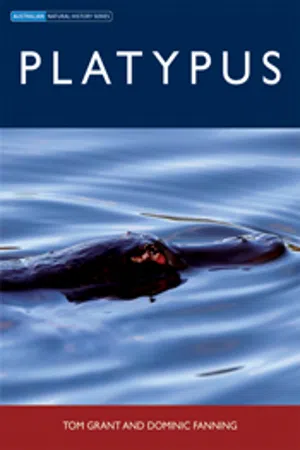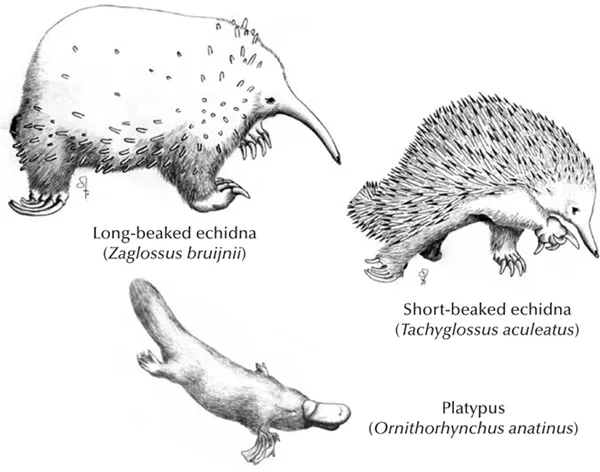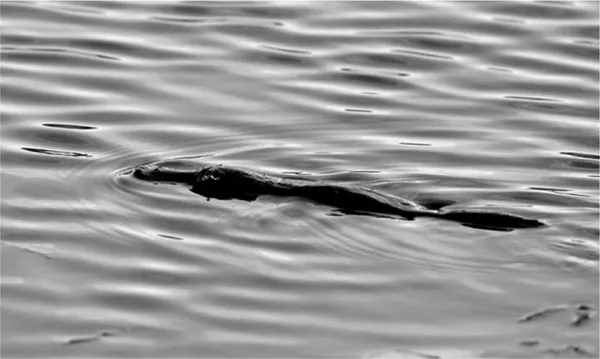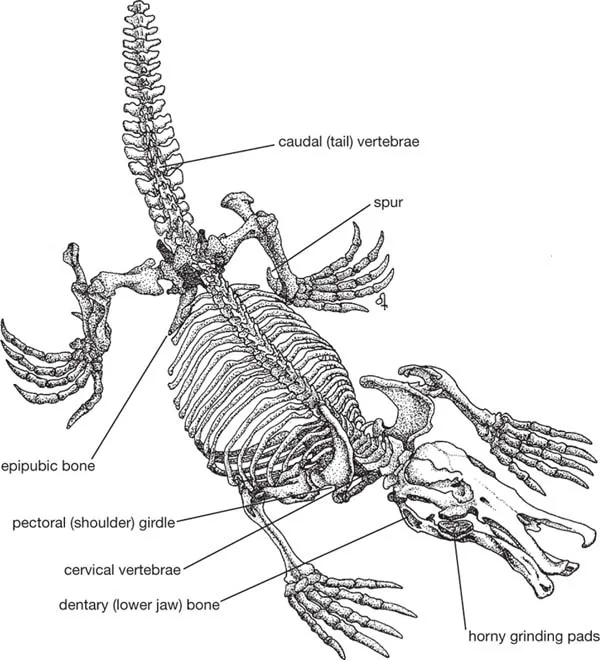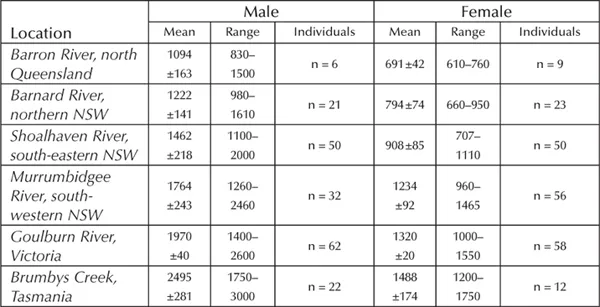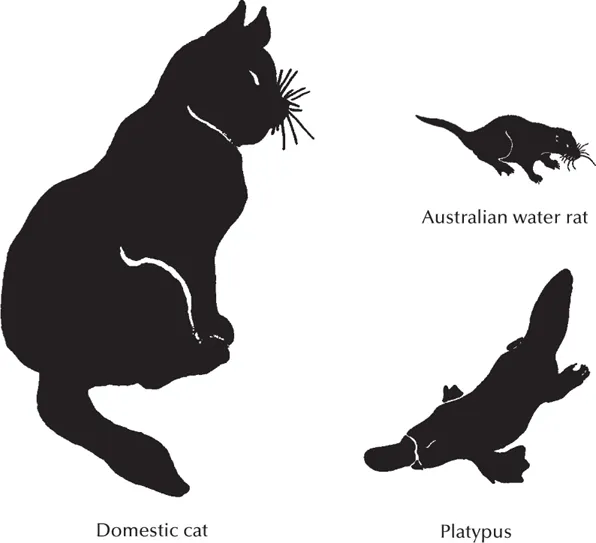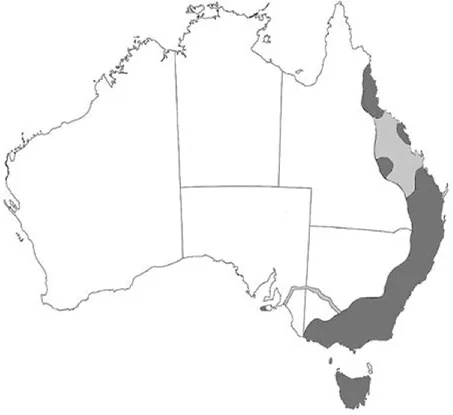![]()
1
INTRODUCTION
‘…. the animal of all time’.
MERV GRIFFITHS (ca 1989)
When first discovered by Europeans, the platypus was thought to be a fake. Various dried or pickled specimens, reaching Britain and Europe at the end of the 18th century, were closely examined by naturalists and scientists determined to find the places where the different bits had been stitched together by a wily antipodean taxidermist. None were found and gradually, but with considerable consternation, acrimony and argument among eminent biologists of the time, the species was finally recognised as a unique mammal indeed, perhaps the ‘animal of all time’.
The Monotremes: the egg-laying mammals
The Class Mammalia consists of two distinct sub-classes, those that give birth to live young (Sub-class Theria – the eutherian or placental and the marsupial mammals) and those that lay eggs (Sub-class Prototheria – the monotremes). There are two living families of monotremes: the echidnas or spiny ant-eaters (Family Tachyglossidae) and the platypus (Family Ornithorhynchidae). Although the long-beaked and short-beaked echidnas and the platypus are the only three commonly known monotremes (Figure 1.1), additional rare species of echidna have been recently recognised to occur in New Guinea. But even including these less common species, the modern monotremes belong to a very small and unique group.
Figure 1.1 The three most common species of monotremes have similarities but the platypus is very different from the two species of echidna.
The long-beaked echidnas occur only in New Guinea, where they inhabit alpine meadows and humid montane forests. Their distribution and abundance are poorly understood and even the most well-known species, Zaglossus bruijnii, is considered by the International Union for Conservation of Nature and Natural Resources (IUCN) to be endangered, due to the clearing of its forest habitat for agriculture and as a result of hunting using dogs and modern firearms. Long-beaked echidnas, in fact, are neither ant-eaters nor particularly spiny. They eat mainly worms, centipedes, beetles and other terrestrial insects, and have only a few spines. The short-beaked echidna (Tachyglossus aculeatus), on the other hand, is very spiny and feeds predominantly on ants and termites, a ubiquitous food source that occurs throughout its distribution in Australia and parts of New Guinea.
Externally, the short-beaked and long-beaked echidnas appear quite different from each other, and both appear very different from the single living platypus species, Ornithorhynchus anatinus. However, they all share their egg-laying habit and have a good number of internal similarities, particularly their skeletons, which place them in the Order Monotremata. These unique species, previously thought to be a first evolutionary ‘experiment’ of the mammalian condition, are in fact highly adapted remnants of a once much more diverse radiation of egg-laying mammals.
Despite their unusual egg-laying reproduction, more often associated with birds or reptiles, the monotremes are definitely considered to be mammals; they suckle their young on milk and have fur- or hair-covered bodies (including spines in the echidnas which are modified hairs). The bones of the pectoral and pelvic girdles are quite similar to those of certain reptiles, but the rest of their skeletons are definitely mammalian. The lower jaw consists of a single pair of bones, the dentaries, which form a hinge with the squamosal bone in the skull, as occurs in all mammals. The inner ear is also mammalian, having three sound-conducting ossicles: the malleus, incus and stapes.
The platypus
Several other species of small vertebrates that occupy various waterways of eastern Australia can be mistaken for the platypus. Figure 1.2 shows that, when resting on the surface of the water between foraging dives, the platypus presents a very low profile, often making it very difficult to see. During the dive, the back is arched as the animal thrusts downwards and forwards. This dive creates a spreading ring, similar to, but subtly different from, the one left by a fish jumping. When the animal surfaces again to breathe, there is also a ring in the water, which frequently catches the light in the rising or setting sun in the morning or late afternoon. When this ring appears, however, the three small humps of head, back and tail remain visible, confirming the presence of a platypus. Occasionally the platypus will swim on the surface and create a low bow wave (see Colour Plate (top), page 33). The native water rat (Hydromys chrysogaster) also creates a bow wave when swimming, but this wave is more pronounced than that of the platypus. The water rat’s body moves in a sinuous manner and it does not arch its back when diving. It also has a long tail, often with a visible white tip, and the external ears can normally be seen when the animal is swimming on the surface. The eastern water dragon (Physignathus leseuerii) overlaps much of the distribution of the platypus in eastern Queensland, New South Wales and into the north-east of Victoria. However, this species is more easily distinguished from the platypus in the water. The water dragon holds its head quite high in the water. There is no diving action, the animal simply seems to slip below the surface. Its swimming is noticeably much more sinuous in nature than either that of the water rat or the platypus. People sometimes report hearing a platypus ‘plop’ into the water. A platypus seldom ‘plops’ – it slides into the water. Those who hear such a noise are more likely to be reporting a freshwater turtle dropping into the water from a log or rock, where they often bask in the sun. Introduced carp (Cyprinus carpio) rolling at the surface, cormorants fishing and some other water birds diving are sometimes mistaken for a platypus. Most often these misidentifications are made by people who have not seen a platypus in the wild. Once seen, the profile and distinctive diving action of Ornithorhynchus anatinus are seldom forgotten.
Figure 1.2 The profile of the platypus in the water often makes it difficult to be seen from the stream bank. Photo: © Ian Montgomery, birdway.com.au
Physical features
No other animal on Earth looks quite like the platypus. Figure 1.3 shows the most notable of its external features and Figure 1.4 highlights the unique nature of its internal skeleton.
Figure 1.3 The main external features of the platypus.
Of course, the most distinctive feature is the bill, which is not hard like the bill of a duck, but soft and pliable. It is well supplied with nerves and is used by the animal to locate food and to find its way around under water. Behind the bill on either side of the head are two grooves that close when the platypus dives. These house the ear openings and the eyes (see Colour Plate (bottom), page 33). The lower bill is smaller than the upper and is supported by the single pair of elongated dentary bones (Figure 1.4). The nostrils are on the top of the bill, not far back from the tip. They are raised slightly and the bill can be extended upwards so the animal is able to breathe at the surface when the rest of its body is almost completely submerged.
Platypuses are not as large as most people expect, with an adult female being much smaller than the average household cat (Figure 1.5). A very large male can be 60 cm from tip of bill to tip of tail but most are 40–50 cm long. There is distinct sexual dimorphism in the species, with male platypuses being larger than females. However, there is considerable size variation within a population and among animals from different localities. In general, platypuses from north Queensland are the smallest, with an increase in size going south to Tasmania, where the largest animals are found. A Tasmanian male platypus, weighing in at 3 kg, is three times as heavy as an average male from north Queensland. The species also exhibits size variations that do not appear to be related to its latitudinal distribution. For example, individuals from the west-flowing rivers in New South Wales are larger than those found in the state’s east-flowing streams. Table 1.1 shows the weights of samples of platypuses caught at a number of locations by research workers in Queensland, New South Wales, Victoria and Tasmania.
Figure 1.4 The internal skeleton of the platypus shows mammalian, reptilian and uniquely platypus features.
Table 1.1. Weights (in grams) of samples of platypuses from study sites in north Queensland, south-eastern and south-western New South Wales, Victoria and Tasmania (data collected from various research workers).
Figure 1.5 The silhouettes of the platypus, the Australian water rat and a household cat show that the platypus is much smaller than many people expect.
The platypus is covered with a dense waterproof fur, except on its feet and bill. It has a streamlined shape, short limbs and propels itself through the water using alternate kicks of its webbed front limbs. Most other aquatic mammals, including the native Australian water rat (Hydromys chrysogaster), use their back feet for propulsion. When the animal is walking or burrowing, the webs of the forefeet fold back to expose strong claws. The rear feet are only partially webbed, acting as rudders during swimming. The sharp claws on the back feet are used for grooming and to anchor the body during burrowing activities. Each of the male’s rear legs bears a horny spur on the ankle of about 1.5 cm in length. This hollow spur is connected by a duct to a venom gland in the upper leg. A series of vertebrae with flattened transverse processes supports the tail, which consists mainly of fatty tissue and acts as a fat storage area.
The skeleton is streamlined but at the same time heavy enough to support large muscles, particularly in the shoulders and front limbs used both for swimming and digging. In most marsupial and eutherian mammals the pectoral (shoulder) girdle is made up of only two pairs of bones – the scapulae (shoulder blades) and clavicles (collar bones). Interestingly, the pectoral girdles of the monotremes are most like those found in the group of fossil reptiles thought to have given rise to the mammals during evolution. Like the monotremes, these had pectoral girdles formed from five bones, including an interclavicle which, in the platypus, is a distinctive T-shaped bone between the collar bones and the sternum. The interclavicle is also found in modern reptiles. Like the marsupials, the platypus has two epipubic bones attached to its pelvic girdle. The function of these is completely unknown in either group. Suggestions that they support the pouch have been rejected, because the platypus as well as all male marsupials and the females of certain marsupial species do not have pouches, but all have epipubic bones.
The legs of the platypus are splayed, rather like those of reptiles, but they rotate in their sockets as do those of all mammals. The ribs are somewhat reptilian. There are rudimentary ribs on the cervical (neck) vertebrae, as in certain reptiles, but there are seven of these vertebrae, which is a unique mammalian characteristic, like the possession of only a single pair of bones in the lower jaw. In platypuses, the deciduous juvenile teeth are lost a short time after the young leave the nesting burrows, and are replaced by horny pads made of keratin. These ‘tooth substitutes’ are renewed as the chewing of food and material from the river bed wears them down. Before being lost, the juvenile teeth are hardened with an enamel similar in structure and composition to that found in fossilised adult teeth from one of the extinct platypus species, Obdurodon insignis (Chapter 7).
Distribution
Because the platypus is dependent on water in which to feed, its distribution is restricted to parts of Australia where permanent streams occur, although it can persist in occasionally ephemeral streams where permanent pools act as refuges during times when stream flows are reduced or absent due to drought conditions. The overall distribution map shown in Figure 1.6 indicates only the general area of continental mainland Australia, Tasmania and two off-shore islands where the species is known to occupy bodies of water and their riparian margins (stream banks and edges). Even within the catchments of the major rivers, distribution of the platypus may be restricted or fragmented as a result of natural or human influence on the availability of suitable habitat.
Figure 1.6 The current distribution of the platypus is shown...
